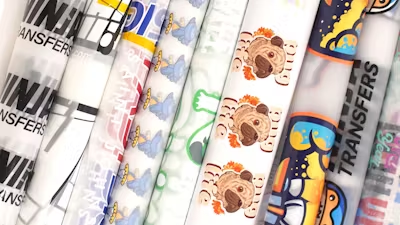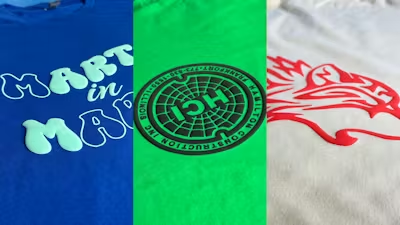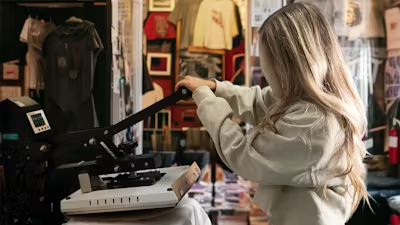Direct-to-film transfers have quickly become a go-to method for creating custom apparel. They offer a blend of quality and efficiency that appeals to t-shirt businesses of all sizes. If you're working with DTF technology, you've likely encountered a crucial decision: choosing the right transfer film.
Hot peel, cold peel, and warm/cool "Easy Peel" films each offer different benefits, impacting your workflow, the types of designs you can create, and even the fabrics you can work with. This article breaks down the key differences between these film types, their pros and cons, and when to use each one. Understanding these options will help you make informed decisions and ultimately get better results. Let's jump in.
Hot peel, cold peel, and the innovative Easy Peel films each offer different benefits, impacting your workflow, the types of designs you can create, and even the fabrics you can work with. This article breaks down the key differences between these film types, their pros and cons, and when to use each one. Understanding these options will help you make informed decisions and ultimately get better results. Let's jump in.
Table of contents
- Types of DTF Transfer Films
- Hot Peel DTF
- Cold Peel DTF
- Easy Peel DTF
- Factors Affecting Transfer Film Choice
- Tips for Successful DTF Transfers
- Conclusion

Types of DTF transfer films
When it comes to choosing a type of DTF transfer film, there are three main players: hot peel, cold peel, and warm/cool peel. Each type is named for how it behaves during the transfer process, particularly when peeling off the film after heat pressing.
- Hot peel: This film is designed to be removed immediately after pressing while it's still hot. It's all about speed and efficiency.
- Cold peel: As the name suggests, you'll need to wait for this one to cool down completely before peeling. Patience is key here.
- Easy Peel: This revolutionary option combines the best of both worlds, allowing you to peel immediately or wait, offering unparalleled flexibility-warm or cool.
These differences can affect your workflow, the types of designs you can create, and the fabrics you can work with. Let's take a closer look at each type, its unique characteristics, advantages, and best use cases.

Hot peel DTF transfer film
Hot peel DTF transfer film is designed for quick, efficient transfers. Here's what you need to know about this fast-paced option:
Characteristics and composition:
- Main component: Wax-based
- Texture: Often results in a glossy finish
- Appearance: Can look like standard paper or a semi-transparent film
Peeling process:
- Timing: Peel immediately after pressing while still hot
- Temperature: Usually pressed at 270-300°F (140-150°C)
- Duration: Short press time, typically 5-10 seconds
Advantages:
- Speed: Fastest turnaround time, ideal for high-volume production
- Efficiency: Can produce up to 100 t-shirts per hour
- Versatility: Works well on a variety of common fabrics
Disadvantages:
- Less suitable for intricate designs or fine details
- May not adhere as well to special fabrics like canvas or flannelette
- Potential for lifting if not pressed at a high enough temperature
- Requires quick and decisive peeling, which can be challenging for beginners
Best use cases:
- Large-volume production runs
- Simple, bold designs
- Standard fabrics like cotton t-shirts
- When time is of the essence
Hot peel film shines in situations where speed and efficiency are top priorities. It's a popular choice for many high-volume print shops and businesses that need to produce a large number of transfers quickly. However, it may not be the best choice for every project, especially those requiring fine detail or special fabric considerations.

Cold peel DTF transfer film
Cold peel DTF transfer film offers a different approach, prioritizing detail and versatility over speed. Here's what you should know about this patient performer:
Characteristics and composition:
- Main component: Silicon-based
- Texture: Often results in a matte finish
- Appearance: Typically a semi-transparent film or paper, allowing you to see the design through the back
Peeling process:
- Timing: Peel after the transfer has completely cooled, typically 30 seconds to a minute
- Temperature: Usually pressed at 300-340°F (150-170°C)
- Duration: Longer press time, typically 10-20 seconds
- Use a Cool Peel Air Blower to accelerate the cooling process
Advantages:
- Better for complex, intricate designs and fine details
- Excellent for special fabrics like tarpaulin, coated cloth, canvas, and flannelette
- Superior long-term wash fastness due to oil-based adhesive layer
- More forgiving if alignment isn't perfect (can reposition before cooling)
Disadvantages:
- Slower process due to cooling time
- Less efficient for high-volume production
- Generally more expensive than hot peel film
Best use cases:
- Detailed, intricate designs
- Printing on special or textured fabrics
- When print quality and durability are top priorities
- Smaller production runs where time isn't as critical
Cold peel film excels in situations where print quality and versatility are more important than speed. It's the preferred choice for projects that require fine details or when working with challenging fabrics. The longer cooling time allows the adhesive to set properly, resulting in transfers that often have better durability and wash resistance.
Warm/cool "Easy Peel" DTF transfer film
Ninja Transfers' Easy Peel DTF transfers offer the best of both worlds, combining the speed of hot peel with the quality of cold peel. This revolutionary technology provides unmatched flexibility and ease of use. Here's what makes our versatile Easy Peel option stand out:
Characteristics and composition:
- Proprietary formulation allows for flexible peeling temperature
- Texture: Balanced finish between glossy and matte
- Appearance: Similar to standard transfer paper, with clear visibility for precise positioning
Peeling process:
- Timing: Peel hot after just 5 seconds, or wait longer if preferred
- Temperature: Press at 310°F / 155°C
- Duration: Approximately 13 seconds press time
- Flexibility to peel hot or cold
Advantages:
- Unparalleled flexibility in peeling time and temperature
- No need to pre-press or pre-iron garments
- Excellent balance between speed and detail retention
- Suitable for a wide range of fabrics
- Allows for multiple pressings without damage if needed
- Highly forgiving for beginners and experts alike
- Enhanced color vibrancy for richer, more vivid designs
- Built to withstand 60+ washes, maintaining quality and stretchability
Disadvantages:
- May require some experimentation to find the ideal peeling time for specific projects
Best use cases:
- Versatile option for various project types and volumes
- Ideal for shops that handle a variety of job types
- Perfect for both simple and detailed designs
- Great for businesses looking to optimize workflow without sacrificing quality
Easy Peel film is designed to offer maximum flexibility and ease of use. It provides an optimal solution for those who want the benefits of both hot and cold peel methods without the drawbacks. This type of film is particularly beneficial for businesses that handle a mix of high-volume and detailed work or for those who are new to DTF transfers and want a more forgiving option.
A key advantage of Easy Peel film is its versatility in the peeling process. You can peel hot after just 5 seconds for quick turnaround, or wait longer if you prefer. If you notice any parts of the design aren't adhering properly, you can lay the film back down and repress without damaging the transfer. This flexibility allows for quality checks and adjustments during the process, ensuring optimal results every time.

Factors affecting DTF transfer film choice
Choosing the right DTF transfer film isn't just about personal preference. Several key factors can influence which type of film will work best for your specific project:
Fabric type:- Standard fabrics (cotton, polyester blends): All film types generally work well
- Special fabrics (canvas, flannelette, coated materials): Cold peel or Easy Peel often perform better
- Synthetic materials: May require specific temperature considerations, making Easy Peel a safer choice
- Simple, bold designs: Hot peel can be efficient and effective
- Intricate details or fine lines: Cold peel or Easy Peel usually provide better results
- Photorealistic images: Cold peel typically offers the best detail retention, but Easy Peel can also achieve excellent results
- High volume runs: Hot peel's speed can be advantageous, but Easy Peel offers similar speed with added flexibility
- Mixed volume or smaller batches: Easy Peel offers excellent versatility
- Low volume, high-quality focus: Cold peel's attention to detail may be worth the extra time, but Easy Peel can often achieve similar quality with more flexibility
- Tight deadlines: Hot peel or Easy Peel can help meet quick turnarounds
- Balanced deadlines: Easy Peel offers a good compromise between speed and quality
- Quality-focused projects: Cold peel's longer process may be justified, but Easy Peel can often achieve similar results faster
- Beginners: Easy Peel is highly forgiving and easier to work with
- Experienced users: May prefer the speed of hot peel, the quality of cold peel, or the versatility of Easy Peel, depending on their typical projects
- Glossy finish: Hot peel often provides a shinier result
- Matte finish: Cold peel typically offers a more subdued look
- Balanced finish: Easy Peel can provide a middle ground or be adjusted with a final press
- Cold peel often provides superior long-term durability
- Easy Peel offers excellent durability, especially with the recommended final press
- Hot peel may require more careful washing but can still be durable when applied correctly

Tips for successful DTF transfers (regardless of film type)
While each type of DTF transfer film has its own specific requirements, there are some general best practices that can help ensure success across the board:
Heat press settings:- Always check the manufacturer's recommended temperature and time settings
- Use a reliable heat press with accurate temperature control
- Consider investing in a heat press with digital time and temperature displays for precision
- Ensure your heat press applies even pressure across the entire transfer area
- For uneven surfaces or challenging placements (like hats), consider using heat press pillows or pads
- Check your heat press regularly for even pressure distribution
- A quick pre-press can remove moisture and wrinkles from the garment
- This step can significantly improve transfer adhesion and longevity
- Use alignment tools or templates for consistent placement
- For Easy Peel and cold peel films, take advantage of the ability to see through the transfer for precise positioning
- When it's time to peel, do so in one smooth, confident motion
- For hot peel, act quickly and decisively
- For Easy Peel, enjoy the flexibility to peel immediately or wait
- For cold peel, resist the urge to peek too early
- Consider a quick second press with a guard sheet or parchment paper
- This can help seal the edges and enhance durability
- Always test new designs or fabrics before starting a big production run
- Keep notes on what works best for different combinations of designs and fabrics
- Store your DTF transfer films in a cool, dry place
- Handle films carefully to avoid bending or creasing
- Learn more about how to store your DTF transfers
- Keep your heat press clean and well-maintained
- Regularly check and replace any worn parts
- Keep up with new developments in DTF technology
- Don't be afraid to experiment with different techniques and settings
- Learn expert techniques and pro tips for free at Ninja University

Optimizing your DTF transfers: The power of informed film selection
When it comes to DTF transfer films, there's no one-size-fits-all solution. Hot peel, cold peel, and Easy Peel films each have their strengths, catering to different needs and preferences. Your choice ultimately depends on your specific projects, production volume, and desired outcomes. Whether you prioritize speed, detail, or versatility, there's a DTF transfer film that fits the bill.
For those seeking a balance of quality, efficiency, and flexibility, Easy Peel films offer an excellent solution. They combine the best aspects of both hot and cold peel, providing unparalleled versatility and ease of use.
If you'd like to experience this versatility firsthand, try our custom-printed transfers. Our top-quality Easy Peel transfers deliver exceptional results across a wide range of applications. For those who prefer to print their own transfers, we offer the same high-quality DTF film rolls we use in-house. Make sure to check out Ninja Blanks for all your quality blank apparel needs.
Whatever your DTF transfer goals, remember that the right combination of film, technique, and materials is key to achieving professional, long-lasting results. With Easy Peel technology, you can enjoy the best of both worlds - the speed of hot peel and the quality of cold peel - all in one versatile solution.
















